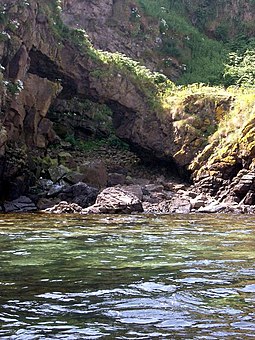Sheep Island, Argyll: Difference between revisions
moved page to Sheep Island, Argyll and Bute |
m add {{Use dmy dates}} |
||
| (31 intermediate revisions by 21 users not shown) | |||
| Line 1: | Line 1: | ||
{{Use dmy dates|date=April 2022}} |
|||
{{Infobox Scottish island |
|||
|official_name=Sheep Island |
|||
|location_map=Scotland Argyll and Bute |
|||
|caption=Sheep Island shown within Argyll and Bute |
|||
|coordinates = {{coord|55.29128|N|5.57209|W|region:GB_source:enwiki-osgb36(NR733055)|display=title}}<!-- Note: WGS84 lat/long, converted from OSGB36 grid ref --> |
|||
|GridReference=NR7328305574 |
|||
|Image=Sheepislandkintyre.jpg |
|||
|ImageCaption=A natural arch on Sheep Island |
|||
|celtic name= |
|||
|gaelic pronunciation= |
|||
|norse name= |
|||
|meaning of name= |
|||
|area= |
|||
|area rank= |
|||
|highest elevation= |
|||
|Population=0 |
|||
|population rank= |
|||
|main settlement= |
|||
|island group= |
|||
|local authority=[[Argyll and Bute]] |
|||
|references= |
|||
}} |
|||
'''Sheep Island''' is a small uninhabited island situated off the southern tip of the [[Kintyre]] [[peninsula]] in Scotland. |
|||
Sheep Island, along with [[Sanda Island]] and [[Glunimore Island]], form a small group of islands approximately {{convert|3|km|mi|0|abbr=off|spell=on}} south of [[Kintyre]] at {{gbmapping|NR733055}}. |
|||
Running roughly north to south, the island is around {{convert|600|m|yd|abbr=off|round=50}} long, and is steep and precipitous along the west coast, rising to a maximum height of {{convert|41|m|ft|0|abbr=off}}. There is a cave on the west coast and a [[natural arch]] at the northwest of the island.<ref>{{cite web|url=http://www.scottish-places.info/features/featurefirst1577.html|title=Sheep Island|publisher=Gazetteer for Scotland|accessdate=19 November 2018}}</ref> A considerable reef of drying rocks surrounds the island and makes landing on the island problematic. There are a number of strong [[tidal race]]s in the area, '''Tum ba nach''' is one that extends north from Sheep Island to around halfway across the Sound of Sanda. |
|||
As the name suggests, sheep have traditionally been grazed here, however the island is more notable as the primary breeding ground for [[Atlantic puffin|puffins]] in the Clyde. From here the birds are returning to nearby [[Ailsa Craig]], where they were once wiped out. [[Guillemot]]s and [[razorbill]]s also nest on Sheep Island. |
|||
== References == |
|||
{{Reflist}} |
|||
{{Commons category|Sheep Island, Scotland|Sheep Island}} |
|||
{{Islands of the Clyde}} |
|||
{{Portal bar|United Kingdom|Scotland}} |
|||
[[Category:Islands of the Clyde]] |
|||
[[Category:Uninhabited islands of Argyll and Bute]] |
|||
[[Category:Natural arches of Scotland]] |
|||
Latest revision as of 19:13, 11 April 2022
 A natural arch on Sheep Island | |
| Location | |
|---|---|
| OS grid reference | NR7328305574 |
| Coordinates | 55°17′29″N 5°34′20″W / 55.29128°N 5.57209°W |
| Administration | |
| Sovereign state | United Kingdom |
| Country | Scotland |
| Council area | Argyll and Bute |
| Demographics | |
| Population | 0 |
Sheep Island is a small uninhabited island situated off the southern tip of the Kintyre peninsula in Scotland.
Sheep Island, along with Sanda Island and Glunimore Island, form a small group of islands approximately three kilometres (two miles) south of Kintyre at grid reference NR733055.
Running roughly north to south, the island is around 600 metres (650 yards) long, and is steep and precipitous along the west coast, rising to a maximum height of 41 metres (135 feet). There is a cave on the west coast and a natural arch at the northwest of the island.[1] A considerable reef of drying rocks surrounds the island and makes landing on the island problematic. There are a number of strong tidal races in the area, Tum ba nach is one that extends north from Sheep Island to around halfway across the Sound of Sanda.
As the name suggests, sheep have traditionally been grazed here, however the island is more notable as the primary breeding ground for puffins in the Clyde. From here the birds are returning to nearby Ailsa Craig, where they were once wiped out. Guillemots and razorbills also nest on Sheep Island.
References[edit]
- ^ "Sheep Island". Gazetteer for Scotland. Retrieved 19 November 2018.

